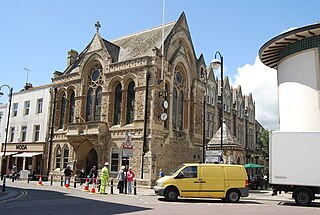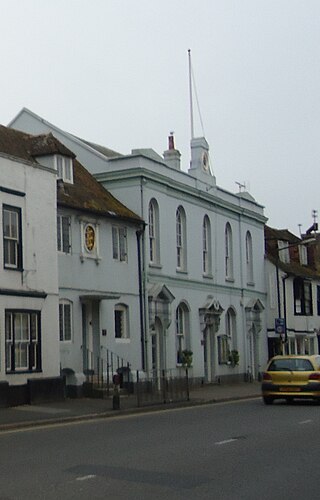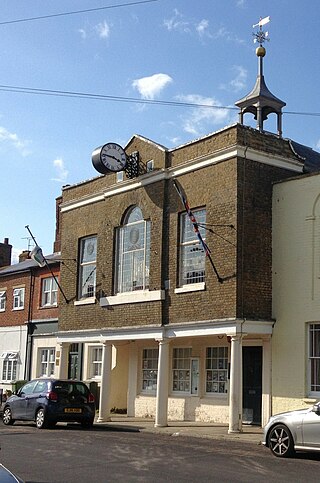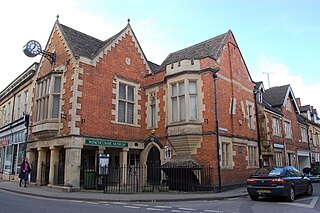
Winchelsea is a town in the county of East Sussex, England, located between the High Weald and the Romney Marsh, approximately 2 miles (3.2 km) south west of Rye and 7 miles (11 km) north east of Hastings. The current town, which was founded in 1288, replaced an earlier town of the same name, known as Old Winchelsea, that was lost to coastal erosion in the late medieval period. Winchelsea is part of the civil parish of Icklesham.
Unreformed boroughs were those corporate towns in England and Wales which had not been reformed by the Municipal Corporations Act 1835. A handful of these obtained new charters under the 1835 Act. A royal commission was established in 1876 to inquire into these boroughs, and legislation passed in 1883 finally forced the reform or dissolution of these corporations by 1886.

Cowbridge Town Hall is a public building in the High Street of Cowbridge in South Wales. The town hall, which is the meeting place for Cowbridge with Llanblethian Town Council, and also houses the town clerk's office, the committee rooms and the Cowbridge Museum, is a Grade II* listed building.

Hastings Town Hall is a municipal building in Queen's Road, Hastings, East Sussex, England. The town hall, which was the meeting place of Hastings Borough Council, is a Grade II listed building.

Farnham Town Hall is a municipal building in South Street, Farnham, Surrey, England. It provides the offices and the meeting place of Farnham Town Council.

The Moot Hall is a municipal building in the High Street in Maldon, Essex, England. The building, which was the headquarters of Maldon Borough Council, is a Grade I listed building.

Little Bolton Town Hall is a municipal building in All Saints Street, Little Bolton, Greater Manchester, England. The structure, which was the meeting place of the trustees of Little Bolton, is a Grade II listed building.

Helston Guildhall, formerly Helston Town Hall, is a municipal building on Market Place, Helston, Cornwall, England. The structure, which is the meeting place of Helston Town Council, is a Grade II* listed building.

New Romney Town Hall is a municipal structure in the High Street, New Romney, Kent, England. The structure, which is the meeting place of New Romney Town Council, is a Grade II listed building.

Queenborough Guildhall is a former municipal building in the High Street in Queenborough, Kent, England. The structure, which is currently used as a museum, is a Grade II listed building.

The Moot Hall is a municipal building in Market Cross Place in Aldeburgh, Suffolk, England. The building, which is the meeting place of Aldeburgh Town Council, is a Grade I listed building.

The Old Town Hall is a municipal building in The High Street in Steyning, West Sussex, England. The building, which was used as a courthouse and a public events venue, is a Grade II listed building.

The Old Guildhall is a municipal building in Higher Market Street in Looe, Cornwall, England. The structure, which is currently used as a museum, is a Grade II* listed building.

Higham Ferrers Town Hall is a municipal building in the Market Square in Higham Ferrers, Northamptonshire, England. The structure, which serves as the offices and meeting place of Higham Ferrers Town Council, is a Grade II listed building.

The Old Town Hall is a municipal building in South Street in Seaford, East Sussex, England. The structure, which is now in commercial use, is a Grade II listed building.

Lydd Guildhall, also known as Lydd Town Hall and the Lydd Common House, is a municipal building in the High Street, Lydd, Kent, England. The structure, which accommodates the offices and meeting place of Lydd Town Council, is a Grade II listed building.

Pevensey Court House, formerly known as Pevensey Town Hall, is a municipal building in the High Street, Pevensey, East Sussex, England. The structure, which currently accommodates a local history museum, is a Grade II listed building.

Winchcombe Town Hall is a municipal building in the High Street, Winchcombe, Gloucestershire, England. The structure, which accommodates the Winchcombe Folk and Police Museum, is a Grade II listed building.

Winchelsea Court Hall Museum is a local museum in Winchelsea, East Sussex, southern England.

The Prince of Wales Inn, formerly Kenfig Town Hall, is a public house in Heol Gorllewin, Kenfig, Bridgend County Borough, Wales. The structure, which used to be a municipal building, is a Grade II listed building.




















